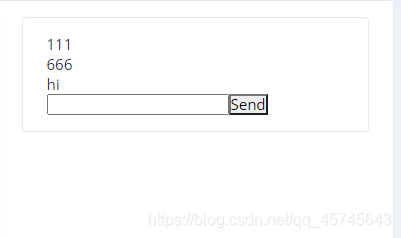Angular使用socket.io实现通信 在Angular项目使用socket.io实现通信的方法
陈仙生 人气:0step1、为项目安装依赖
在终端输入以下命令为我们的angular项目安装express、socket.io、socket.io-client
npm install express socket.io socket.io-client
本人安装的各版本信息如下:
"express": "^4.17.1", "socket.io": "^3.0.4", "socket.io-client": "^3.0.4",
step2、编写后台服务
可以在项目中新建一个server文件夹,用来存放我们的后台服务,然后新建文件
const app = require('express')();
const http = require('http').createServer(app);
const io = require('socket.io')(http, {
cors: { // 处理跨域问题
origin: "http://localhost:4300", // angular项目的启动端口,默认4200,本人项目的启动端口为4300,大家根据自己情况修改
methods: ["GET", "POST"],
credentials: true
}
});
io.on('connection', (socket) => {
console.log('user connected');
socket.on('add-message', (message) => {
io.emit('message', {type: 'new-message', text: message});
});
})
http.listen(4000, () => { // 后台服务启动端口
console.log('start on 4000....');
})
step3、创建angular服务
import { Injectable } from '@angular/core';
import { Observable, Subject } from 'rxjs';
import { io } from 'socket.io-client';
@Injectable()
export class ChatService {
private url = 'http://localhost:4000'; // 后台服务端口
private socket: any;
sendMessage(message: any) {
this.socket.emit('add-message', message);
}
getMessages(): Observable<any> {
return new Observable(observer => {
this.socket = io(this.url, {withCredentials: true});
this.socket.on('message', (data) => {
observer.next(data);
});
return () => {
this.socket.disconnect();
}
})
}
}
这里我们创建了两个方法,sendMessage用于将客户端的信息发送给服务端,getMessages用于建立连接,监听服务端事件并返回一个可观察的对象。
step4、创建组件
import { Component, OnInit, OnDestroy } from '@angular/core';
import { ChatService } from './chat.service';
@Component({
selector: 'test-chat',
template: `<div *ngFor="let message of messages">
{{message.text}}
</div>
<input [(ngModel)]="message" />
<button (click)="sendMessage()">Send</button>`,
providers: [ChatService] // 注入依赖
})
export class TestChatComponent implements OnInit, OnDestroy {
messages = [];
connection: any;
message: any;
constructor(private chatService: ChatService) {
}
sendMessage() {
this.chatService.sendMessage(this.message);
this.message = '';
}
ngOnInit() {
this.connection = this.chatService.getMessages()
.subscribe(message => { // 组件初始化时订阅信息
this.messages.push(message);
});
}
ngOnDestroy() {
this.connection.unsubscribe(); // 组件销毁取消订阅
}
}
这样一个简单的socket通信就完成了,效果图如下:
启动服务

前端页面


如果遇到跨域问题,大概率是没有处理跨域,检查自己的代码和端口号是否正确,详情参考handing-cors
另外,如果遇到(本人遇到了,愣是在网上找了半天依然未果)
POST http://localhost:4000/socket.io/?EIO=3&transport=polling&t=NQtz_E3 400 (Bad Request)
这类的报错,npm安装socket.io-client(这也是为什么我在文章一开始就安装它),在service.ts文件引入
import { io } from 'socket.io-client';
在网上看到很多人是这样写的 import * as io from ‘socket.io-client',这种写法在typescript中是会报错的,改成上面的写法即可。
加载全部内容